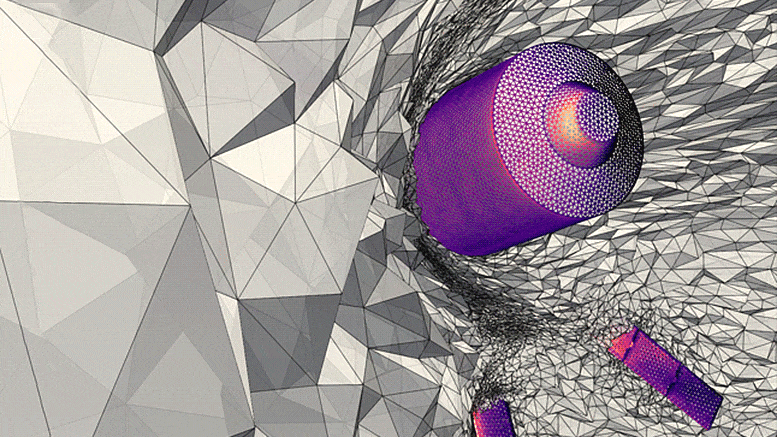This simulation of ESA’s Automated Transfer Vehicle (ATV) space truck reentering Earth’s atmosphere starts by representing the surrounding of the spacecraft as a three-dimensional cloud of interconnected points, a so-called ‘computational grid’.
This forms part of the process of modeling the hypersonic motion of gases around the falling spacecraft through ‘Computational Fluid Dynamics’.
This study of the ATV’s demise took place as part of the MIDGARD (MultI-Disciplinary modellinG of the Aerothemodynamically-induced fragmentation of Re-entering boDies) activity of the European Space Agency’s Open Space Innovation Platform with the University of Strathclyde’s Department of Mechanical & Aerospace Engineering. This ongoing activity aims at reducing the uncertainty of the simulation of destructive atmospheric entry by combining highly accurate but expensive and low-fidelity and fast simulation methods.
A total of five ATVs resupplied the International Space Station between 2008 and 2015, all of them disposed of by atmospheric reentry. Europe’s largest spacecraft leaves a longer-term legacy as the basis for the European Service Module of the NASA-ESA Orion spacecraft, designed to return astronauts to the Moon, and planned to fly on NASA’s first Artemis mission later this year.
Destructive atmospheric reentry is a traditional way of disposing of spacecraft and satellites at the end of their working lives, but ESA and international regulations state that the risk of injury to people or property on the ground must be lower than one in 10,000.

Credit: University of Strathclyde
Fábio Morgado of the University of Strathclyde, working on MIDGARD, states: “Addressing the risk of the atmospheric reentry of space debris is progressively becoming more and more pressing due to the increase in the number of orbiting objects and the consequent higher frequency of reentry. The prediction of the reentry processes is impacted by the progressive fragmentation and thermal erosion of the re-entering objects as a result of the severe aerothermal loads.”
Prof. Marco Fossati, Principal Investigator of MIDGARD and Fabio’s supervisor, adds: “Improved modeling and simulation of the aerothermodynamically-induced fragmentation is paramount to design systems for safe demise and to assess the associated ground impact risk.”
An event in Bordeaux, France, at the end of this month will bring together experts in the ‘aerothermodynamics’ of reentry as well as ‘design for demise’ – the practice of designing space hardware to make it more likely to fully burn up in the atmosphere, rather than having any element survive down to the ground.
In the past, heavy elements such as propellant tanks or instrument optic benches have reached the ground intact, but redesigning systems to use lighter parts or making them more likely to break apart earlier in reentry can mitigate against this.
This latest Aero Thermo Dynamics & Design for Demise workshop, ATD3, is being organized by ESA with French space agency CNES with the help of the HYFAR-ARA Hypersonic Flight and Atmospheric Re-entry Association.
The ATD3 workshop will take place on October 27-28.
- aum and Karlston
-

 2
2




Recommended Comments
There are no comments to display.
Join the conversation
You can post now and register later. If you have an account, sign in now to post with your account.
Note: Your post will require moderator approval before it will be visible.